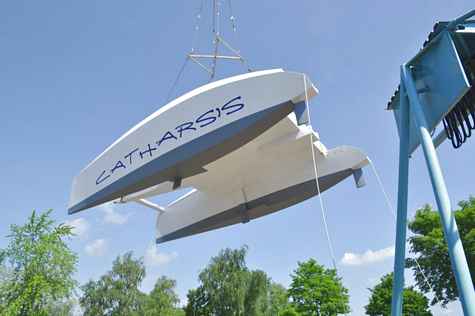Keyboard Shortcuts
ctrl + shift + ? :
Show all keyboard shortcuts
ctrl + g :
Navigate to a group
ctrl + shift + f :
Find
ctrl + / :
Quick actions
esc to dismiss
Likes
Search
Re: Leeboards
¿ªÔÆÌåÓýAndrew:
??? I did read Pete's post, and that's exactly why I suggested leaving both luffboards down. ??? The area of the hull above the pivot on a leeboard, and the pivot pin itself, support the load on a leeboard.? Usually a slotted structure at the gunnel or near it, accepts the top of the leeboard when deployed.? Thus it is pulling outboard at the gunnel, and pressing inboard on the area around the pivot pin when in use.?? Reverse the tack with a leeboard down, and you reverse the forces, but of course you also reverse the heel. ??? Bernd's luffboards are exactly the reverse situation as the leeboard.?? The tension is on the shaft, and the compression load at the top.? There is a big difference however when you change tacks, as the luffboard closely follows the hull below the pivot shaft.?? With the luff board down on the "wrong tack", the luffboard is going to lay against the hull, so the tension loads above will be far lighter.?? An ordinary leeboard cannot be anywhere near the hull, while Bernds' luffboards follow it closely...........? The result is that I have zero structural concerns about reverse forces.?? ??? My only concern is how it would tack with both down........ not the structural loads.??? ??? The central folding dagger is a far better solution than the standard dagger in my opinion because it can fold back if it strikes something.......... But it means that a strong nacelle type structure must be placed beneath the bridge deck.?? The fact that the bow waves tend to pile up in the center however means more "grip" for the length of the board. ??? In any case the central dagger lacks to my mind the fundamental elegance and simplicity that I see throughout the KD 860 design.??? I would love to see the AV panels work, and was very disappointed with the results some builders such as yourself were having with them.?? If the issue is the lack of the sharp edge Bernd mentions on his site, or insufficient panel area, that is fairly easily remedied.? If as Bernd suggested the other day, it's an issue of not enough hull immersed ( too low aspect ratio to be an effective wing ), then there is no solution except boards or keels.?? ??? As I've mentioned before, I don't really anticipate building a KD 860, but I would hope to find one within my budget someday.? But if I were building one, I would definitely concentrate on that sharp corner, and perhaps increase the area of the AV panel.? I'd probably also build the luffboard support structure at the outset, weather or not I installed the boards later.? I don't believe that their location conflicts with the AV panels, but lacking plans, I don't really know that.?? That structure would be my proverbial "ace in the hole" which would allow me to easily convert later if necessary. ??? The PDF Luffboard1.pdf shows the luffboard structure being right where the curvature of the leading edge of the bridge deck flattens out, if I read the drawing right....... in line with the mast step. ??? The photo showing the launch of Catharsis KD 860 found here:? ??? Seems to show both luff boards and AV panels, the luff boards being forward of the AV panels and having to slide past them to swing aft and retract....... I don't quite understand this conflict.?????  ??? ??? ??? ??? ??? ??? ??? ??? ??? ??? ??? ??? ??? ??? ??? ??? ??? ??? ??? ??? ??? ??? ??? ??? ??? ??? H.W. On 12/07/2017 05:27 PM, andrewklees@... [k-designs] wrote: ?
|
to navigate to use esc to dismiss
